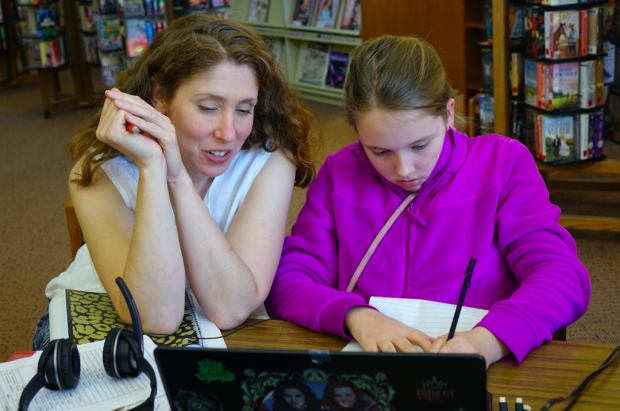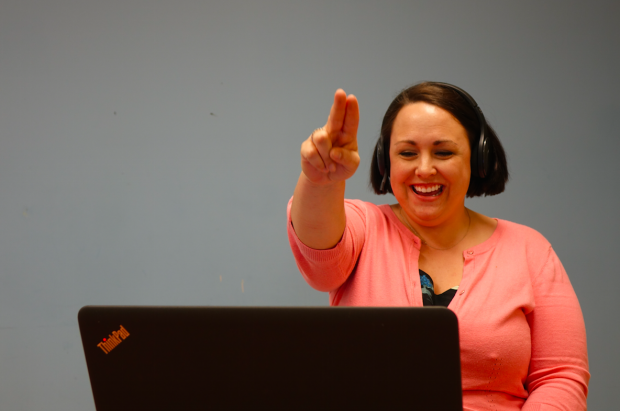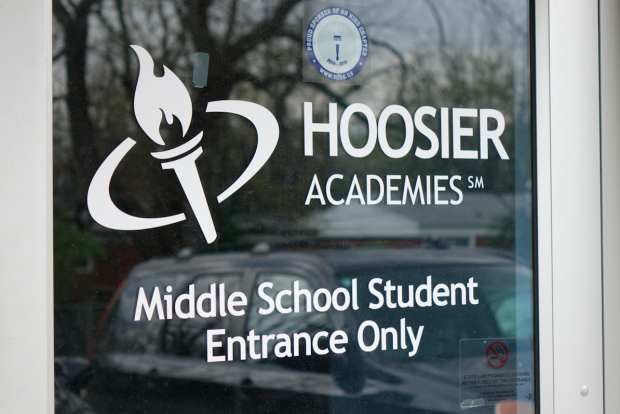After Years Of Second Chances, Indiana Online School Remains Chronically Failing

Anna Allman laughs with daughter Piper as they review German language words as part of Piper’s Hoosier Virtual Academy foreign language course at the Mooresville Public Library on April 18, 2017. Allman says she’d be devastated if the school was closed because “individual students that are being positively impacted — such as our family.” (Eric Weddle/WFYI News)
Hoosier Academies Virtual School was near the brink of closure by the Indiana State Board of Education in March 2015 when the board opted for a one-year delay on casting a verdict.
Then, there was a call for another delay.
- After Years Of Second Chances, Indiana Online School Remains Chronically FailingHoosier Academies Virtual School was near the brink of closure by the Indiana State Board of Education in March 2015 when the board opted for a one-year delay on casting a verdict.Download
Now, more than two years since Indiana’s first online charter school became eligible for state intervention due to chronic failure, the state board will consider whether to shutter it or take a less severe type of intervention during a meeting Wednesday in Evansville.
“It’s unfortunate it’s been this many years,” says recently elected State Superintendent of Public Instruction and board chair Jennifer McCormick about the school’s ongoing academic failures. “But it is what it is and we have to take some action.”
McCormick says action is needed because Indiana is not benefiting from hundreds of students failing or dropping out at Hoosier Academies Virtual School.
When it opened in 2009, Hoosier Academies Virtual was Indiana’s first online school. Now, there are four Indiana public schools that offer 100-percent online classes to about 10,000 K-12 students, including some who cite health, social and bullying issues as the reason for choosing online education.
Hoosier Academies Virtual School serves nearly 3,200 students in all 92 counties and earned six consecutive Fs on the state’s accountability scale — two more than what’s required for state intervention of a charter school.
Here are some statistics based on 2015-16 academic year data and reports on the current school year:
- 60 percent of the senior class cohort dropped out before graduation.
- 81 percent of students failed the state required ISTEP exam.
- 1,200 students enrolled and later unenrolled or were kicked out
- 246 students were expelled for truancy
Hoosier Virtual officials and their charter authorizer Ball State University are set to offer a turnaround plan, designed in part by former Indiana School Chief Tony Bennett, that seeks to build a new academic culture at the school. The plan emphasizes more direct contact with students, renewed efforts to enroll students in AP courses, and professional development for staff.
The school officials also say they need to improve data collection and fully switch the K-12 curriculum from Common Core State Standards to the three-year-old Indiana Academic Standards.
How the state board will weigh such a plan after six years of chronic failures, remains to be seen.
So, what is certain?
Byron Ernest, a political appointee to the State Board of Education, will recuse himself from the vote on Wednesday. He runs Hoosier Academies, a network of three Indianapolis-based online-learning schools that includes Hoosier Virtual.
Ernest, a past Indiana teacher of the year who posts daily about educational leadership to his 632,000 Twitter followers, was hired in 2014 by Virginia-based K12 Inc. — the country’s largest operator of for-profit charter schools — to turn around the failing Hoosier Academies. At the time, Ernest was working for another for-profit charter management company, the Florida-based Charter Schools USA, as the principal of Emmerich Manual.
The high school, formerly part of Indianapolis Public Schools, was one of five failing schools taken over by the state in 2011 with a controversial action overseen by Bennett. Under Ernest’s watch, Manual’s has been the only school to improve its state grade to D.
“I’m just a believer that schools don’t really ever need to get to that point,” Ernest says about takeover. “And so, therefore (I’m) really trying to look at what are the identifiers and how do we keep schools from getting into that situation.”

Hoosier Virtual Academy teacher Alissa Davis gets the attention of her kindergarten class on April 13, 2017, at the Hoosier Academy administrative office. Using a web camera, Davis interacts with around 10 5-year-old students who are watching and interacting via computers at their homes. (Eric Weddle/WFYI News)
At Hoosier Virtual, Ernest says a handful of major challenges are driving the school’s failure as measured by the state: high school-age kids enrolling with few credits required to graduate and large student turnover. Last year 5,132 unique students enrolled at some point yet the state’s fall student count was 3,861 students — that means more than 1,200 students left the school after enrolling.
“I want, I really want those students,” Ernest says about those struggling at traditional schools and lagging behind in credits. “But I also know that it’s going to be really hard to meet this accountability system in that kind of a world.”
Ernest says the state’s A-F accountablity scale is not designed for a school like Hoosier Virtual.
Bob Marra, Ball State’s executive director of the Office of Charter Schools, and John Marske, Hoosier Academies board president, will make the case Wednesday that the state should weight those issues against improvements and plans to reshape how the staff track and report data.
K12, Inc. hired the Center For Education Reform, Bennett and Amy Marsh, a former Indiana Department of Education staffer, to design the action plan that will be presented to the board.
But others questions whether these obstacles are out of the ordinary for a virtual charter school.
Karega Rausch, vice president of research and evaluation of the National Association of Charter School Authorizers, or NACSA, wouldn’t comment on Hoosier Academies Virtual School specifically but says the evidence is clear that online schools underperform.
The NACSA that promotes charter school accountability and even advocates for poorly run charter schools to be closed.
Data shows that in a given year, full-time virtual charter school students overall make no gains in math and less than half the gains in reading as do their peers in traditional public schools, according to an NACSA report.
Those findings align with a just-released report from the Indiana DOE that found that student achievement at Hoosier Virtual, “is a consistent downward trend on both math and English/Language Arts proficiency coupled with very low student growth.”
“You have brick and mortar schools that also struggle with student mobility and student turnover and are finding ways of reducing that and engaging that,” Rausch says. “So I am not certain that high turnover or student mobility by itself is a reason to give any school a pass.”
Despite the data, some families are rallying behind Hoosier Virtual.
Excel And Achieve
Anna Allman makes it clear: her family loves Hoosier Academies Virtual School.
“It’s been such a great thing for us,” Allman says while her two daughters complete assignments on laptop computers at the Mooresville Public Library last month. “It’s really allowed them to excel, to achieve — I truly believe — way beyond what we could have gotten in our traditional school.”
What is way beyond?
Grace, 14, is in her second year of Mandarin Chinese and as a 10th grader is working towards an honors diploma. Piper, 11, is taking German for the second year.
The two attend online classes five days a week. A typical day begins with an 8 a.m. class for Grace. Allman, a nurse who also take on the role of teacher aid at home, will review subjects with Piper before her classes begin at 9 a.m.
“It’s helped me along in my education and I’ve enjoyed it,” Grace says shyly after completing a lesson the on Civil Rights movement. “I’ve gotten really good at managing my time because you don’t have a teacher looking over your shoulder all the time. It’s more independent learning.”

Anna Allman laughs with daughter Piper as they review German language words as part of Piper’s Hoosier Virtual Academy foreign language course at the Mooresville Public Library on April 18, 2017. Piper’s older sister Grace listens to a lecture on American history. Both children have been enrolled in the online school for five years. (Eric Weddle/WFYI News)
Students at Hoosier Virtual log on to special software and use a microphone and webcam that lets them talk with and see classmates and the teacher. They hold class discussions or hash out an equation together — all from their personal computers. All that, Piper says, makes her feel like she’s almost in a traditional classroom.
“I think it helps a lot of other students’ too,” she adds.
The family found out about Hoosier Academies Virtual School five years ago. That’s when a 9-year-old Grace, then a third-grader in a local school, was mastering math at a pace way beyond her classmates at the public school, Allman says. So teachers there sought out a supplement.
“They actually put a Hoosier Academy computer in the classroom and she did a math course,” Allman says.
Grace took to the computerized learning. But when the school offered the pre-teen to take advanced math at the high school, Allman says, the family wanted another option.
They enrolled both at Hoosier Academies Virtual School. Allman says the K12, Inc. curriculum is rigorous and allows for customized learning. If Grace is, again, bypassing her peers in a math course, the teacher can offer more advanced work.
“Teachers are paying attention and looking for ways to customize the learning,” she says.
Allman says she can’t speak to the hundreds of students failing at the school — why their experience is opposite of her children. But she says choosing Hoosier Virtual was intentional for its online format just as is her dedication to assisting Grace and Piper daily.
“We’d be devastated if the school was closed,” she says. “You’ve got this grades on schools but you’ve got to break it down and look at the individual students that are being positively impacted — such as our family.”
Yet some worry that Hoosier Academies Virtual School can be hurting the very students who come to the school as a last resort.
A ‘High Rate’ Of Expulsion
One way the school deals with the high volume of students who stop logging into class: Expulsion.
In the past three years, the school kicked out over 800 students for truancy.
In the 2015-16 academic year, 246 students were expelled. That ranks Hoosier Virtual as the third highest expulsion rate in the state at 6.4 percent, based on the October 1, 2015 enrollment count. But the number of expulsions at the other tops schools looks quite different.
The alternative McClean Education Center in Vigo County, the highest ranked, expelled 12 out of 122 students for a 9.8 percent rate.
By comparison, the state’s largest district, Fort Wayne Community Schools with around 30,000 students, expelled just 7 students last year.
The virtual Indiana Connections Academy, a K-12 online school based in Indianapolis with 4,000 students, reported 65 expulsions last year and 177 suspensions.
The rate of expulsion troubles McCormick because public schools don’t have to accept students if another school expelled them. These students, she says, may be left with few options to complete high school.
“I’m not sure how appropriate expulsion would be for participation and attendance issues. I think that is a real concern,” she says. “You know that’s going to happen in an online environment. So how do you address it and how are you proactive versus being reactive and expelling kids because they haven’t logged on.”
But a new state law, signed this month by Gov. Eric Holcomb, gives backing for online schools to do just that.
The law requires Indiana virtual schools adopt a “student engagement policy,” that sets guides for expelling a student “who regularly fails to participate” in coursework.
Ernest, who says he was involved in “conversations” about the legislation, defends the expulsions. At Hoosier Academies Virtual School, he says, it’s the only way staff can deal with the high volume of students skipping online classes from their homes in cities and towns across the state.
“That’s one of the bigger challenges — children enrolling here, coming here and then not doing anything once they’ve started,” he says. “And so that’s why that rate is high.”
Expulsion proceedings begin three days after a student or parent has not logged on to the school’s system. After 10 days of truancy, the student is expelled.
The staff is trying to reach out to families during these 10 days to get them back on track, Ernest says.
Part of the school’s improvement plan includes creation of the Family Academic Support Team, or FAST, which focus on “the needs of new and struggling students.” These teams, plus growing relationships with Child Protective Services and other groups in some counties, have helped increase contact with truant students and families.
“We’re not where we want to be on that yet,” Ernest says. “But I think in the last two years we’ve really ramped up how we [handle truant students].”
‘Unfair Advantage’
Shortly after Hoosier Academies Virtual School hired Ernest, he appeared in front of the Indiana state board of education. At the March 2015 meeting, he fought for his school to remain open.
By this time, Hoosier Virtual had earned four consecutive Fs on the state’s A-F accountability system — a trigger for charter schools that makes them eligible for various types of state intervention.
Ernest testified that the online school’s mission was to “bring in all students who need an alternative environment,” according to meeting minutes and that a dedication to struggling students impacted test scores.
The board voted 8-2 to delay taking action and give the school a year to improve or face possible closure again.

Byron Ernest, head of schools for Hoosier Academies, was appointed to the State Board of Education in May 2015 by Indiana House Speaker Brian Bosma for a four-year term. The Indiana State Teachers Association and others have questioned whether the board has been slow to sanction Hoosier Virtual Academy because of his membership. Ernest has recused himself from all discussions about Hoosier Virtual. (Eric Weddle/WFYI News)
Three months later Ernest was appointed to the State Board of Education, following legislation that required the board to be reshuffled, in wake of infighting between former state Schools Chief Glenda Ritz, a Democrat, and some of the board members appointed by Republican governors.
The idea was to give legislators more of a hand in education policy by letting the Speaker of the House and President Pro Tempore of the Senate each appoint one member and while the governor’s office appoints eight members.
When House Speaker Brian Bosma chose Ernest, he described the 2010 teacher of the year as “a strong agent of education improvement for our state.”
Bosma made no mention that the State Board of Education would again vote whether to shut down Hoosier Academies Virtual School.
While the State Board had given Ernest and Ball State a year to improve the school and return for another hearing, it was 18 months later in September 2016 when Hoosier Virtual was back on the agenda.
“It’s been, I would say, an unfair advantage,” said Teresa Meredith, Indiana State Teachers Association president, about Ernest’s role and the numerous delays the state board has provided the school. “It just seems inappropriate on the surface, it just seems like such a conflict.”
Ernest says he understands why some question a conflict but he’s resolute there is none.
“I have not talked about this and nor will I — not with (board) staff, not with anyone,” he says. “I can very comfortably say, I have not inserted myself in this at all or talked to anyone as (House Speaker Bosma’s) appointee.”
During past state board meetings when Hoosier Academies Virtual School was discussed, Ernest left the room. Ball State’s Marra and John Marske, the charter school board’s president, present school data to the board in his place. That’s the plan for Wednesday.
Guidelines by the National Association of State Boards of Education (NASBE) recommend recusal from consideration of an issue such as Ernest’s conflict.
Kristen Amundson, NASBE president, says various degrees of conflict are bound to happen with board appointees in states like Indiana where board members are required to have an education background.
“My understanding is that what he’s done,” she says of Ernest’s recusals, noting that he is also a member of NASBE’s board. “That is exactly what you want from citizen governance.”
Current and former state board of education members say Ernest has shown no attempt to influence.
“He’s been very diligent in making sure that he doesn’t put himself or the school in an awkward situation,” McCormick said.
Though, an awkward situation unfolded last September.
Second School And Last Chance
As Hoosier Academies again faced closure, the school launched a plan that blindsided the state board of education.
Earlier that year, Ball State approved a charter for Hoosier Academies to open a new school in its Indianapolis campus for students enrolled, but struggling academically, at Hoosier Virtual.
Those students could choose to unenroll from Hoosier Virtual and enroll at Insight School of Indiana — a school that combines in-person classroom instruction with online learning.
Insight School of Indiana is based on a K12, Inc. model used in Arizona that “focuses on each student’s academic and personal well-being,” according to the company.

The front door of the Hoosier Academy administrative offices and school on Far Eastside of Indianapolis at 2855 North Franklin Road. The building houses the K-12 Hoosier Academy blended learning school, Hoosier Virtual Academy, and the new Insight School of Indiana middle school. (Eric Weddle/WFYI News)
But the board, unaware of the school opening, questioned if it was means for Hoosier Virtual to avoid intervention. It’d allow Hoosier Virtual to retain more successful students in the online environment, they argued, and shift low performers to a new school.
“It will have a different clientele upon which it will be given a different grade giving you the opportunity to perhaps not have an F,” Ritz, then-superintendent, said. “I’m just going to be blunt.”
When Insight opened on August 22, 455 of the 665 students enrolled had “transferred at family request from the virtual school,” Ernest says.
Reflecting back on that meeting Marske, the Hoosier Academies board president, explained last month that Insight was created to help students, not shirk accountability.
“I mean it obviously took me by surprise too,” Marske says of the board response. “I don’t know how that filter works between the state board and the Department of Education. But it was all conveyed.”
Documents obtained through a public records request show that DOE staff were aware by April 2016 that Hoosier Academies planned to create “Insight School” as a “school within a school model” to help credit deficient students.
Whether Insight will provide another way for Hoosier Academies to help struggling students while more the self-directed students, like the Allmans, succeed in the virtual classroom remains to be seen.
Even if the State Board of Education allows Hoosier Virtual to remain open, their authorizer Ball State University could decline to renew the charter.
Marra, the college’s executive director of the Office of Charter Schools, says he wants to see this year’s ISTEP scores, other end-of-year data, and how the improvement plan has impacted the school.
“I want the opportunity to re-evaluate after things have been changed to see what we do and then that question will come,” he says about considering a charter renewal this fall. “I would like the opportunity to look at all of those new data points and see if they are [improving] and if they are not, then we will close them like we’ve done other schools.”
Ernest won’t speak at Wednesday’s board meeting but when asked last month why Hoosier Virtual deserved another chance, he was adamant.
“I think the important thing is to know, one: We’re working really hard to get better. And I believe we’re on an up-and-up trend of getting better,” Ernest says. “I don’t shirk away that we have continual improvement that needs to keep happening. But I think it’s such an important option for so many students in our state to continue.”
The State Board of Education meets 9 a.m. Wednesday at the University of Evansville, Eykamp Hall, 2nd floor, in Evansville.
Contact WFYI education reporter Eric Weddle at eweddle@wfyi.org or call (317) 614-0470. Follow on Twitter: @ericweddle.